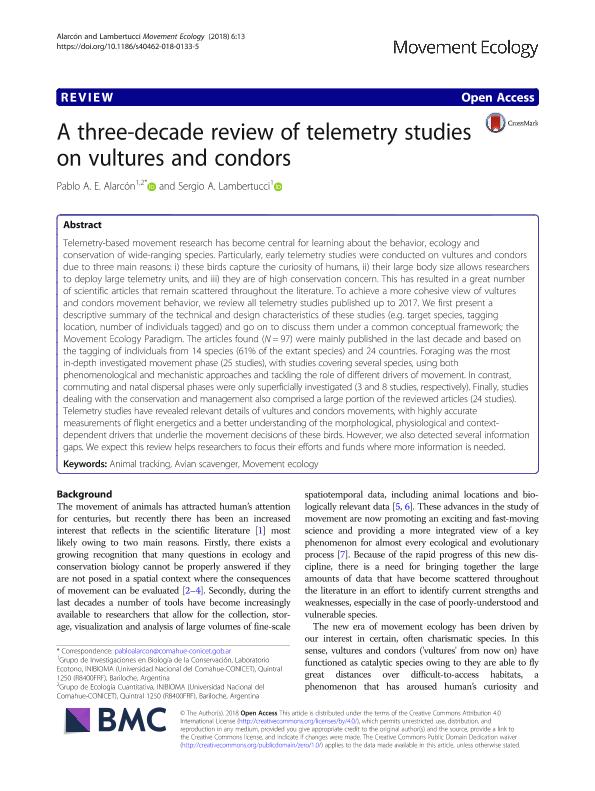Artículo
A three-decade review of telemetry studies on vultures and condors
Fecha de publicación:
04/09/2018
Editorial:
BioMed Central
Revista:
Movement Ecology
ISSN:
2051-3933
Idioma:
Inglés
Tipo de recurso:
Artículo publicado
Clasificación temática:
Resumen
Telemetry-based movement research has become central for learning about the behavior, ecology and conservation of wide-ranging species. Particularly, early telemetry studies were conducted on vultures and condors due to three main reasons: i) these birds capture the curiosity of humans, ii) their large body size allows researchers to deploy large telemetry units, and iii) they are of high conservation concern. This has resulted in a great number of scientific articles that remain scattered throughout the literature. To achieve a more cohesive view of vultures and condors movement behavior, we review all telemetry studies published up to 2017. We first present a descriptive summary of the technical and design characteristics of these studies (e.g. target species, tagging location, number of individuals tagged) and go on to discuss them under a common conceptual framework; the Movement Ecology Paradigm. The articles found (N=97) were mainly published in the last decade and based on the tagging of individuals from 14 species (61% of the extant species) and 24 countries. Foraging was the most in-depth investigated movement phase (25 studies), with studies covering several species, using both phenomenological and mechanistic approaches and tackling the role of different drivers of movement. In contrast, commuting and natal dispersal phases were only superficially investigated (3 and 8 studies, respectively). Finally, studies dealing with the conservation and management also comprised a large portion of the reviewed articles (24 studies). Telemetry studies have revealed relevant details of vultures and condors movements, with highly accurate measurements of flight energetics and a better understanding of the morphological, physiological and context-dependent drivers that underlie the movement decisions of these birds. However, we also detected several information gaps. We expect this review helps researchers to focus their efforts and funds where more information is needed.
Palabras clave:
ANIMAL TRACKING
,
AVIAN SCAVENGER
,
MOVEMENT ECOLOGY
Archivos asociados
Licencia
Identificadores
Colecciones
Articulos(INIBIOMA)
Articulos de INST. DE INVEST.EN BIODIVERSIDAD Y MEDIOAMBIENTE
Articulos de INST. DE INVEST.EN BIODIVERSIDAD Y MEDIOAMBIENTE
Citación
Alarcón, Pablo Angel Eduardo; Lambertucci, Sergio Agustin; A three-decade review of telemetry studies on vultures and condors; BioMed Central; Movement Ecology; 6; 1; 4-9-2018; 1-13
Compartir
Altmétricas




